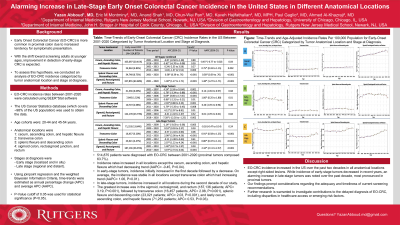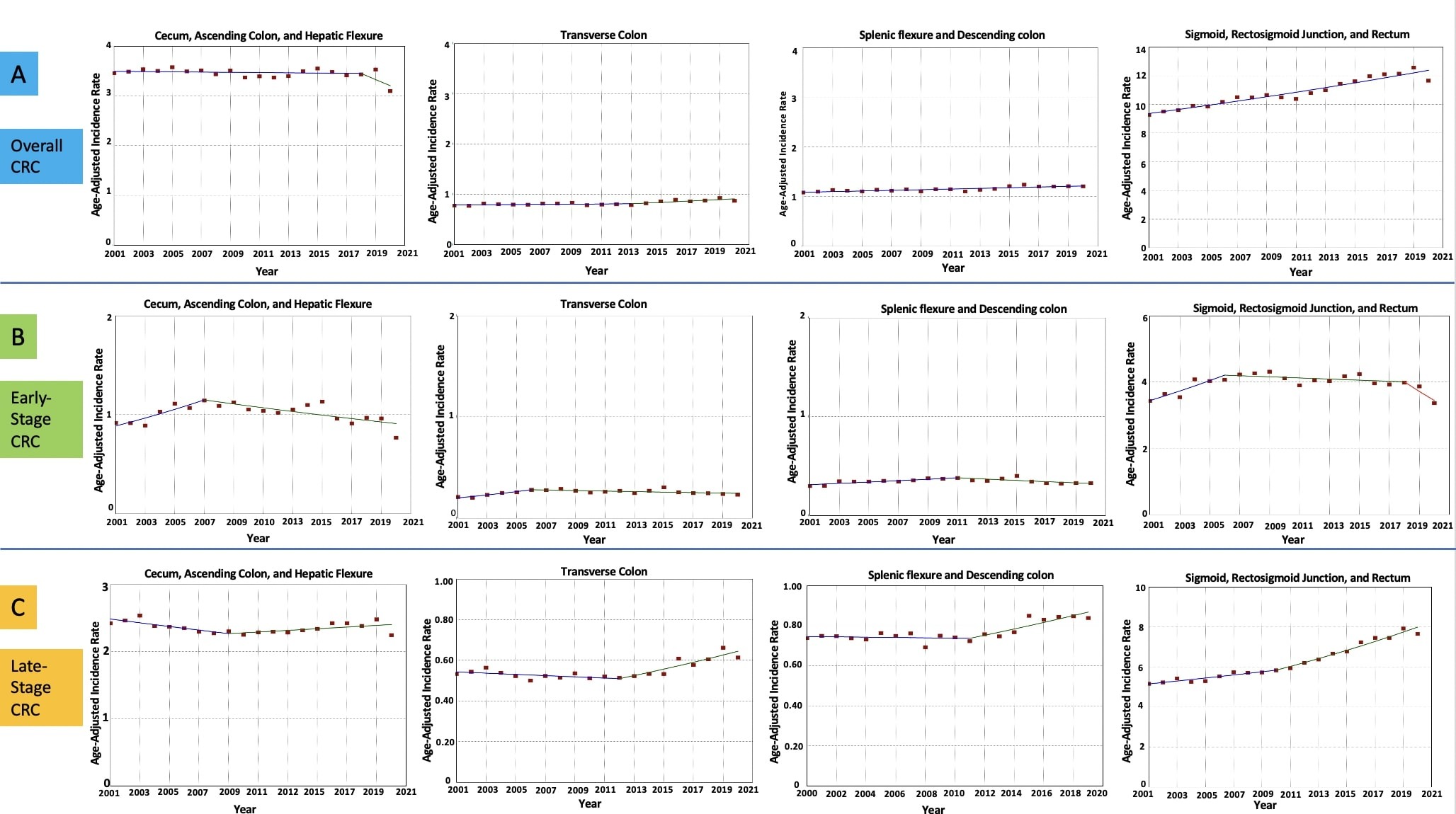Tuesday Poster Session
Category: Colorectal Cancer Prevention
P3867 - Alarming Increase in Late-Stage Early Onset Colorectal Cancer Incidence in the United States in Different Anatomical Locations
Tuesday, October 29, 2024
10:30 AM - 4:00 PM ET
Location: Exhibit Hall E

Has Audio
.jpg)
Yazan Abboud, MD
Rutgers New Jersey Medical School
Newark, NJ
Presenting Author(s)
Yazan Abboud, MD1, Eric Montminy, MD2, Anand Shah, MD1, Chun-Wei Pan, MD3, Kaveh Hajifathalian, MD1, Paul Gaglio, MD4, Ahmed Al-Khazraji, MD1
1Rutgers New Jersey Medical School, Newark, NJ; 2Center for Endoscopic Research and Therapeutics (CERT), University of Chicago, Chicago, IL; 3John H. Stroger, Jr. Hospital of Cook County, Chicago, IL; 4Rutgers NJ Medical School, Newark, NJ
Introduction: Early Onset Colorectal Cancer (EO-CRC) is more common in proximal colon due to increased tendency for symptomatic presentation. With the shift toward screening adults at younger ages, improvement in detection of early-stage CRC is expected. To assess this hypothesis, we conducted an analysis of EO-CRC incidence categorized by tumor anatomical location and stage at diagnosis.
Methods: EO-CRC age-adjusted incidence rates in adults aged 20-54 years between 2001-2020 were calculated from the United States Cancer Statistics database (covers 98% of US population). The rates were categorized by location into 1: cecum, ascending colon, and hepatic flexure, 2: transverse colon, 3: splenic flexure and descending colon, and 4: sigmoid colon, rectosigmoid junction, and rectum. Stages at diagnosis were early (localized and in situ) and late (regional and distant). Annual percentage change (APC) and average APC (AAPC) were estimated using joinpoint regression and weighted Bayesian Information Criteria (P< 0.05).
Results: 514,875 patients were diagnosed with EO-CRC between 2001-2020 (proximal tumors composed 63.7%). Incidence rates increased in all locations except the cecum, ascending colon, and hepatic flexure which had decreasing trend (AAPC= -0.45, P=0.04) (Figure).
In early-stage tumors, incidence initially increased in the first decade followed by a decrease. On average, the incidence was stable in all locations except transverse colon which had increasing trend (AAPC= 1.06, P=0.01) (Table).
In late-stage tumors, incidence increased in all locations during the second decade of our study. The greatest increase was in the sigmoid, rectosigmoid, and rectum (187,136 patients; APC= 3.19, P< 0.001), followed by transverse colon (16,457 patients, APC= 2.98, P< 0.001), splenic flexure and descending colon (23,021 patients; APC= 2.03, P=0.001), and lastly cecum, ascending colon, and hepatic flexure (71,253 patients; APC= 0.53, P=0.03).
Discussion: EO-CRC incidence increased in the US over the past two decades in all anatomical locations except right-sided lesions. While incidence of early-stage tumors decreased in recent years, an alarming increase in late-stage tumors was noted over the past decade, most pronounced in proximal tumors. Our findings prompt considerations regarding the adequacy and timeliness of current screening recommendations. Further research is warranted to investigate contributions to the delayed diagnosis of EO-CRC, including disparities in healthcare access or emerging risk factors.

Note: The table for this abstract can be viewed in the ePoster Gallery section of the ACG 2024 ePoster Site or in The American Journal of Gastroenterology's abstract supplement issue, both of which will be available starting October 27, 2024.
Disclosures:
Yazan Abboud, MD1, Eric Montminy, MD2, Anand Shah, MD1, Chun-Wei Pan, MD3, Kaveh Hajifathalian, MD1, Paul Gaglio, MD4, Ahmed Al-Khazraji, MD1. P3867 - Alarming Increase in Late-Stage Early Onset Colorectal Cancer Incidence in the United States in Different Anatomical Locations, ACG 2024 Annual Scientific Meeting Abstracts. Philadelphia, PA: American College of Gastroenterology.
1Rutgers New Jersey Medical School, Newark, NJ; 2Center for Endoscopic Research and Therapeutics (CERT), University of Chicago, Chicago, IL; 3John H. Stroger, Jr. Hospital of Cook County, Chicago, IL; 4Rutgers NJ Medical School, Newark, NJ
Introduction: Early Onset Colorectal Cancer (EO-CRC) is more common in proximal colon due to increased tendency for symptomatic presentation. With the shift toward screening adults at younger ages, improvement in detection of early-stage CRC is expected. To assess this hypothesis, we conducted an analysis of EO-CRC incidence categorized by tumor anatomical location and stage at diagnosis.
Methods: EO-CRC age-adjusted incidence rates in adults aged 20-54 years between 2001-2020 were calculated from the United States Cancer Statistics database (covers 98% of US population). The rates were categorized by location into 1: cecum, ascending colon, and hepatic flexure, 2: transverse colon, 3: splenic flexure and descending colon, and 4: sigmoid colon, rectosigmoid junction, and rectum. Stages at diagnosis were early (localized and in situ) and late (regional and distant). Annual percentage change (APC) and average APC (AAPC) were estimated using joinpoint regression and weighted Bayesian Information Criteria (P< 0.05).
Results: 514,875 patients were diagnosed with EO-CRC between 2001-2020 (proximal tumors composed 63.7%). Incidence rates increased in all locations except the cecum, ascending colon, and hepatic flexure which had decreasing trend (AAPC= -0.45, P=0.04) (Figure).
In early-stage tumors, incidence initially increased in the first decade followed by a decrease. On average, the incidence was stable in all locations except transverse colon which had increasing trend (AAPC= 1.06, P=0.01) (Table).
In late-stage tumors, incidence increased in all locations during the second decade of our study. The greatest increase was in the sigmoid, rectosigmoid, and rectum (187,136 patients; APC= 3.19, P< 0.001), followed by transverse colon (16,457 patients, APC= 2.98, P< 0.001), splenic flexure and descending colon (23,021 patients; APC= 2.03, P=0.001), and lastly cecum, ascending colon, and hepatic flexure (71,253 patients; APC= 0.53, P=0.03).
Discussion: EO-CRC incidence increased in the US over the past two decades in all anatomical locations except right-sided lesions. While incidence of early-stage tumors decreased in recent years, an alarming increase in late-stage tumors was noted over the past decade, most pronounced in proximal tumors. Our findings prompt considerations regarding the adequacy and timeliness of current screening recommendations. Further research is warranted to investigate contributions to the delayed diagnosis of EO-CRC, including disparities in healthcare access or emerging risk factors.

Figure: Figure: Time-Trends and Age-Adjusted Incidence Rates Per 100,000 Population for Early-Onset Colorectal Cancer (CRC) in Adults Aged 20-54 years Categorized by Tumor Anatomical Location and Stage at Diagnosis.
Note: The table for this abstract can be viewed in the ePoster Gallery section of the ACG 2024 ePoster Site or in The American Journal of Gastroenterology's abstract supplement issue, both of which will be available starting October 27, 2024.
Disclosures:
Yazan Abboud indicated no relevant financial relationships.
Eric Montminy indicated no relevant financial relationships.
Anand Shah indicated no relevant financial relationships.
Chun-Wei Pan indicated no relevant financial relationships.
Kaveh Hajifathalian indicated no relevant financial relationships.
Paul Gaglio indicated no relevant financial relationships.
Ahmed Al-Khazraji indicated no relevant financial relationships.
Yazan Abboud, MD1, Eric Montminy, MD2, Anand Shah, MD1, Chun-Wei Pan, MD3, Kaveh Hajifathalian, MD1, Paul Gaglio, MD4, Ahmed Al-Khazraji, MD1. P3867 - Alarming Increase in Late-Stage Early Onset Colorectal Cancer Incidence in the United States in Different Anatomical Locations, ACG 2024 Annual Scientific Meeting Abstracts. Philadelphia, PA: American College of Gastroenterology.
